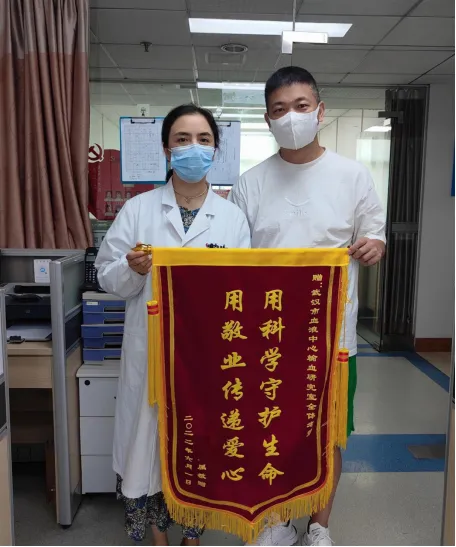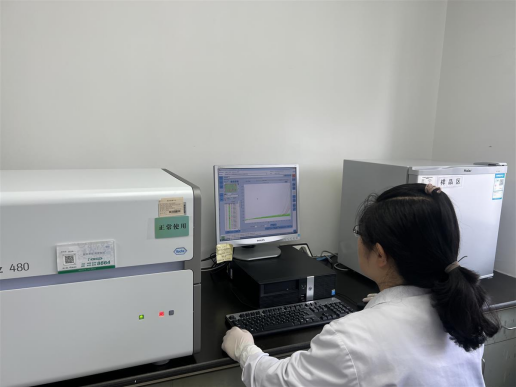

 Now Location:Home--News Center--Company News
Now Location:Home--News Center--Company News
"The patient's body produces platelet antibodies, resulting in ineffective platelet transfusions, which is in danger!" 81 year old Grandma Li suffers from aplastic anemia. She had previously received multiple platelet transfusions in the hospital but failed, leading to systemic skin purpura. Once there is bleeding in the body, her life will be in danger. On the advice of clinical doctors, Mrs. Li submitted her platelet typing application for the first time to the Blood Transfusion Research Laboratory of Wuhan Blood Center in May this year. The center quickly genotyped the patients and performed corresponding "genotyping" in the platelet donor database, accurately recruiting blood donors, and the infusion effect was immediate. At present, after 5 precise platelet transfusions, the patient's condition has stabilized and clinical bleeding symptoms have been effectively controlled.
Last March, 81 year old Mrs. Li (pseudonym) was diagnosed with aplastic anemia and received treatment in several hospitals in Beijing and Wuhan. During the treatment period, due to the patient's particularly low platelet count, which once dropped to single digits, platelet transfusion is needed as an adjunct to treatment, with platelet transfusion almost once a week. After multiple platelet transfusions, the patient's body produced platelet antibodies. Especially since May this year, the effectiveness of platelet transfusion has been deteriorating. Even if a sufficient amount of platelets are transfused, the increase in platelet count is not significant, forming a vicious cycle. The interval between platelet transfusions becomes shorter and shorter, from once a week to once every 4 days, and even the infusion is completely ineffective. Platelet infusion is ineffective, and the patient also presents with extensive subcutaneous hemorrhagic purpura, which can be very dangerous once bleeding occurs in the body.
In this situation, Mr. Cai, the son of Mrs. Li, listened to the advice of clinical doctors and went to Wuhan Blood Center to apply for platelet genetic typing. After the test results were obtained, the platelet gene database was immediately searched, and it was found that the platelet gene of Mr. Wang (surname Hua), a blood donor, matched that of the patient, as well as several blood donors with matching genes.
Mr. Wang, 51 years old this year, is an ordinary employee of the power supply company and also a regular blood donor. On weekdays, as long as his body and time permit, he will come to the blood center to donate blood as soon as the interval arrives. His platelet gene information has been added to the platelet gene database of Wuhan Blood Center. "At that time, I heard from medical staff that my platelets were matched with a patient, and the blood I donated could better help her. I think it's quite meaningful, and I hope I can contribute. After learning that his platelet genotype and Mrs. Li's typing were successful, Mr. Wang was very cooperative and specially donated his own platelets for Mrs. Li.".
On May 27th this year, Grandma Li received her first transfusion of platelets that matched her genes, and the platelet count rapidly increased from 3 × 10 ^ 9/L to 91 × 10 ^ 9/L. After maintaining the frequency of platelet transfusions every 7 days and 5 consecutive transfusions, Grandma Li's condition gradually stabilized.

Mr. Cai, a family member of the patient, presented a banner to the transfusion research room of Wuhan Blood Center
"I really want to thank Wuhan Blood Center for accurately locating and finding genetically matched platelets for patients." According to the attending physician of Grandma Li, due to her older age, she is currently undergoing conservative treatment. After 5 rounds of platelet matching and precise platelet infusion therapy, the effect is quite obvious. Grandma Li's platelet count is close to normal levels, and subcutaneous bleeding has been controlled. The number of platelet transfusions has significantly decreased now, which not only reduces the adverse reactions of platelet transfusions, but also saves patients costs and eliminates the problem of platelet resource waste. It is truly a win-win situation.
"Thanks to the blood donated by these unpaid blood donors, otherwise my mother wouldn't have been saved," Mr. Cai said. Out of gratitude, he also donated whole blood at the beginning of this year. "Next time, I will also donate some blood, after all, my mother has lost so much blood, and the help cannot be exchanged for money. I also need to do something within my ability to repay this society.
In fact, Grandma Li is just one of many patients who need platelet transfusions. In order to enable patients to use platelets that match their genes, Wuhan Blood Center has long targeted "precise matching of platelets". "We will preserve the DNA of blood samples from fixed platelet donors at low temperature for a long time, and build databases of their HLA and HPA genotypes to provide information for patient platelet typing." Shen Gang, director of the Blood Transfusion Research Office at Wuhan Blood Center, introduced that since 2012, the Blood Transfusion Research Office has been following the international technological forefront and has been working on the research of platelet gene database projects. Since 2019, the center has officially screened and established a platelet donor HLA/HPA gene database with a storage capacity of 1516, and the scale is still expanding year by year.

Staff are using Weihe platelet combination reagent for HLA genotyping detection of platelets
It is understood that Wuhan Blood Center, as a member of the first batch of China Platelet Gene Database Collaboration Group, has established the Platelet Gene Database, which is also the only platelet gene database in Hubei Province. Patients only need to contact Wuhan Blood Center through the visiting department or transfusion department, and the blood center will perform HLA and HPA genotyping on the patient's platelets, and search for matching blood donors in the platelet gene database, providing reliable assurance for accurate clinical blood transfusion. In the future, the database will gradually achieve comprehensive digital management of information from application, testing, search, result publishing, and storage data management.
"The final implementation of the platelet gene database project is based on the selfless dedication of a large number of fixed blood donors." The staff of the platelet gene database at Wuhan Blood Center stated that due to the fact that the shelf life of platelets is only 5 days, in most cases, genetically matched blood is recruited on a temporary basis. The interval between component blood donors is 14 days. If the corresponding patient needs to receive platelet transfusions every approximately 7 days, when the interval between suitable blood donors has not expired, multiple gene matched donors are required to provide platelets. Therefore, only with the participation of more blood donors and the establishment of a larger platelet gene database can the needs of more patients be met.
The staff of the platelet gene database at Wuhan Blood Center introduced that there are different types of blood, and typing is required before transfusion, otherwise there is a possibility of rejection reaction and even danger. The blood types commonly known to the public are ABO blood type and Rh negative blood ("panda blood"). The red blood cell typing mainly includes ABO and Rh system blood typing. There are multiple blood group antigen systems on the surface of platelets, including human leukocyte antigen (HLA) and human platelet antigen (HPA). Therefore, in platelet typing, in addition to ABO blood typing, HLA and HPA typing may also need to be performed according to the patient's own situation.
HLA and HPA are both complex antigen systems. Patients who repeatedly receive platelet transfusions have a higher chance of encountering allogeneic HLA and HPA antigens, which stimulate the body to produce more types and quantities of antibodies. As a result, the probability of ineffective platelet transfusions is also higher.
Platelet transfusion is one of the important treatment methods for thrombocytopenia or functional abnormalities caused by leukemia, aplastic anemia, tumor radiotherapy and chemotherapy, etc. Therefore, conducting precise platelet transfusion research is of great significance, especially for patients who have received multiple platelet transfusions. This is also very important for achieving safe, timely, and effective blood transfusion goals, and improving the level of clinical blood transfusion technology.
From "ineffective" to "effective", Li Po Po's precise blood transfusion is a microcosm of the effectiveness of the grassroots monitoring and caring activities carried out by Wuhan Blood Center. It is a typical case of a new type of platelet gene precise infusion method that has achieved good clinical efficacy, and also a strong manifestation of Weihe Biotech's collaboration with the Chinese Blood Transfusion Association industry to actively promote precise matching projects between blood centers and clinical cooperation in various regions. In the future, Weihe Biotechnology will continue to carry out precision blood transfusion projects to safeguard the lives of patients.
This article is from Wuhan Blood Center. If there is any infringement, please contact us to delete it.
